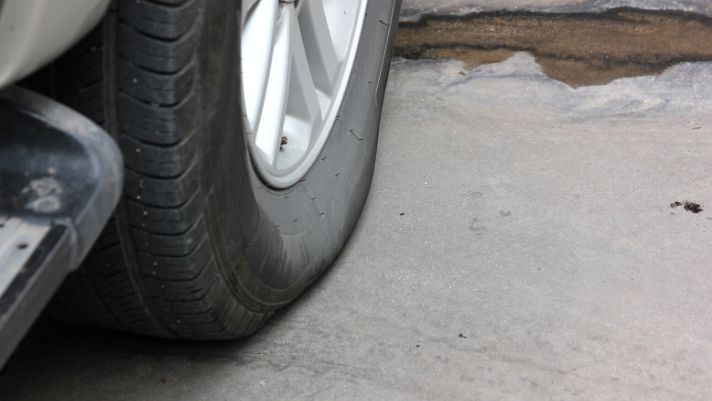How to Know If Your Tire Pressure is Low
To check for low tire pressure, use a pressure gauge on each tire valve. Low pressure may result in poor handling, longer braking distances, and decreased fuel efficiency.
Slight tire deflation is often hard to detect by sight, making regular pressure checks essential. We will discuss the signs of low tire pressure, the importance of maintaining proper inflation, and the impact of underinflated tires on safety. By understanding these factors, you can ensure your vehicle’s tires are properly inflated, enhancing overall performance and safety on the road.
Let’s dive into how you can easily identify if your tire pressure is low and the steps you can take to rectify the issue.
The Importance Of Tire Pressure
Ensuring that your vehicle’s tires are properly inflated is crucial for safety, fuel efficiency, and to extend the lifespan of the tires. Low tire pressure can lead to a range of issues that can adversely affect your driving experience and vehicle performance.
Safety
Proper tire pressure is essential for maintaining grip and traction on the road. Low tire pressure can compromise your ability to control the vehicle, especially in adverse weather conditions. It can also lead to increased stopping distances and the risk of a blowout, posing a serious safety hazard.
Fuel Efficiency
Underinflated tires can increase rolling resistance, causing your vehicle to consume more fuel. By ensuring that your tires are properly inflated, you can optimize fuel efficiency and reduce your overall fuel consumption, ultimately saving money and reducing your environmental impact.
Tire Lifespan
Maintaining the correct tire pressure extends the lifespan of your tires, reducing the need for premature replacements. Underinflated tires can cause uneven wear, leading to the need for more frequent tire changes, while overinflation can cause the center of the tire to wear more quickly.

Credit: www.way.com
Signs Of Low Tire Pressure
Low tire pressure can be a safety hazard, affecting your vehicle’s performance and fuel efficiency. It’s essential to be aware of the signs that indicate your tire pressure is low.
Visual Inspection
A quick visual check of your tires can often reveal low tire pressure. Look for visibly deflated tires, which appear flatter than usual. Inspect for any damage or bulges, which could indicate a leak or underinflation.
Tpms Warning Light
The Tire Pressure Monitoring System (TPMS) in your car is designed to alert you when your tire pressure is low. If you see the TPMS icon illuminated on your dashboard, it’s a clear indication that one or more of your tires need attention.
Uneven Tire Wear
Uneven tire wear can be a sign of low tire pressure. If you notice one tire wearing out faster than the others, it could be due to underinflation. Regularly check your tires for wear patterns to catch any issues early.
Checking Tire Pressure
Regularly checking your tire pressure is crucial for maintaining optimal safety and performance of your vehicle.
Using A Tire Pressure Gauge
Measure the pressure with a tire pressure gauge to ensure it meets the manufacturer’s specifications.
Consulting The Vehicle Manual
Refer to your vehicle manual for the recommended tire pressure levels specific to your make and model.
Visiting A Service Station
For accurate readings and adjustments, consider visiting a service station with proper equipment.
Credit: www.quora.com
Inflating Low Tire Pressure
When it comes to inflating low tire pressure, it’s essential to understand the optimal pressure for your vehicle, the use of an air compressor, and the importance of regular checks. By knowing these key factors, you can maintain the safety and performance of your tires.
Understanding Optimal Pressure
The optimal pressure level for your vehicle’s tires can usually be found in the owner’s manual or on the inside of the driver’s side door. It’s crucial to adhere to these recommended pressure levels to ensure proper handling, fuel efficiency, and tire longevity.
Using An Air Compressor
When inflating low tire pressure, using an air compressor can make the task quick and convenient. Ensure the compressor is equipped with a pressure gauge and use it to fill the tire to the recommended level. Be cautious not to overinflate, as this can lead to uneven wear and reduce traction.
Importance Of Regular Checks
Regularly checking your tire pressure is critical for safety and performance. Low tire pressure can lead to decreased fuel efficiency, poor handling, and increased risk of a blowout. Make it a habit to check your tire pressure at least once a month as well as before long journeys.
Preventing Low Tire Pressure
To determine if your tire pressure is low, regularly check your tire’s PSI using a tire pressure gauge. Look out for signs like uneven tread wear, increased fuel consumption, or a distinct decrease in handling and performance while driving. It is important to maintain proper tire pressure to ensure a safe and smooth ride.
Regularly monitoring tire pressure is essential to ensure optimal tire performance and prevent low tire pressure. Low tire pressure can lead to reduced fuel efficiency, decreased tire lifespan, and compromised handling and safety on the road. By avoiding potholes and debris and maintaining tire valve caps, you can further minimize the risk of developing low tire pressure and its associated problems.
Monitoring Tire Pressure
To prevent low tire pressure, it is crucial to monitor tire pressure regularly. Use a tire pressure gauge to check the pressure in each tire at least once a month. It’s best to do this when the tires are cold, as the pressure can fluctuate when the tires are warm. Refer to the vehicle’s owner’s manual or the sticker located inside the driver’s-side door jamb for the recommended tire pressure for your specific vehicle. If the pressure reading is below the recommended level, inflate the tire to the appropriate pressure using an air compressor or at a nearby gas station. Regularly monitoring tire pressure helps maintain proper inflation and prevent low tire pressure issues.
Avoiding Potholes And Debris
One of the leading causes of low tire pressure is damage caused by potholes and debris on the road. These obstructions can puncture tires or damage the sidewalls, leading to air leakage and decrease in tire pressure. To reduce the risk, it’s important to stay alert while driving and avoid driving over potholes whenever possible. If you encounter unavoidable potholes or debris, slow down and try to straddle them to minimize the impact on your tires. By being cautious and proactive, you can prevent potential damage and maintain proper tire pressure.
Maintaining Tire Valve Caps
Tire valve caps may seem like an inconsequential part of your vehicle, but they play a crucial role in preventing low tire pressure. Valve caps create a seal that keeps air from escaping out of the valve stem. Without them, dust, dirt, and moisture can infiltrate the valve stem, leading to air leakage and decreased tire pressure over time. Ensure that all your tires have valve caps and regularly inspect them for damage or missing caps. If you notice any issues, replace the valve caps promptly to maintain airtight seals and prevent low tire pressure.

Credit: rnrtires.com
Frequently Asked Questions On How To Know If Your Tire Pressure Is Low
How Can I Tell If Tire Pressure Is Low?
You can tell if tire pressure is low by regularly checking the tire pressure with a gauge. Visual inspection for noticeably flattened tires is also a sign of low pressure. In addition, the vehicle may exhibit poor handling and decreased fuel efficiency.
Regular tire maintenance is crucial.
How Do I Know If I Need Air In My Tires?
Check tire pressure regularly. If tires look deflated, use a pressure gauge to ensure they meet manufacturer’s recommendations.
What Does Driving With Low Tire Pressure Feel Like?
Driving with low tire pressure feels like increased vehicle vibrations and reduced handling. You may notice poor gas mileage and uneven tire wear.
Is Low Tire Pressure Noticeable?
Yes, low tire pressure is noticeable. You may feel the car pulling to one side. The steering may feel less responsive. You might notice decreased fuel efficiency. Keeping tires properly inflated is essential for safe and efficient driving. Regularly check your tire pressure to avoid any issues.
How Does Low Tire Pressure Affect Fuel Efficiency?
Low tire pressure increases rolling resistance, causing your vehicle to consume more fuel for the same distance.
What Are The Signs Of Low Tire Pressure?
Look out for decreased fuel efficiency, a soft or sinking tire, and frequent alerts from your tire pressure monitoring system.
How Often Should I Check My Tire Pressure?
It is recommended to check your tire pressure at least once a month, or before long trips.
Conclusion
To sum up, maintaining proper tire pressure is crucial for safety and performance. Regularly check the pressure using a tire gauge and make adjustments as needed. Being aware of the signs of low tire pressure and taking proactive measures can help prevent accidents and extend the life of your tires.
Stay vigilant and keep those tires properly inflated!

